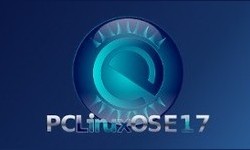Alternate OS - Icaros Part 4
by Darrel Johnston (djohnston)First things first. I have some corrections to add to the previous articles.
In Part 1 I said, "Most who used Amiga computers in the 1970s and 1980s came to love the capabilities of the machines." According to the Amiga History site, "The Commodore Amiga was officially launched in September 1985 for £1,500." Hey, I was only off by a decade! I can remember where I was when President Kennedy was shot, but my memory sometimes fails me spectacularly in other ways. Had I done basic research, I would have caught that blatant error. Stuff happens. My apologies to nimrod7 on the Amigaworld forum, and to any others who caught that error. So, if you were running an Amiga in 1975, you were ten years ahead of your time!
Next, in Part 1 I said, "binaries already compiled for AmigaOS will not run, even if they are compiled for the same family of CPU." According to HenryCase, also on the Amigaworld forum, (and the AROS-EXEC forum), that is incorrect. As Henry states, "This simply isn't true, as can be seen with all the 68k Amiga software that runs on AROS 68k." In other words, much of the Amiga software written for the Motorola 680x0 CPUs will also run unmodified on the 68k version of AROS. This was also pointed out by Tzimisce on the AROS-EXEC forum.
In Part 2 I said, "The messaging system of AmigaOS's Exec library is very fast and flexible, based originally on Tripos." According to Wikipedia's AmigaOS article, "In AmigaOS 1.x, the AmigaDOS portion was based on TRIPOS, which is written in BCPL. Interfacing with it from other languages proved a difficult and error-prone task, and the port of TRIPOS was not very efficient. From AmigaOS 2.x onwards, AmigaDOS was rewritten in C and Assembler, retaining full 1.x BCPL program compatibility, and it incorporated parts of the third-party AmigaDOS Resource Project[3], which had already written replacements for many of the BCPL utilities and interfaces." So, only AmigaOS version 1.x's version of DOS was based on TRIPOS. A better explanation, as pointed out by HenryCase, comes from http://www.thule.no/haynie/caos.html:
"As most of you know, AmigaDOS was not the first choice for the top-level OS/DOS on the Amiga computer. What we now call AmigaDOS was really the backup DOS, based on an already existing OS known as Tripos (developed at the University of Cambridge Computer Laboratory by the TRIPOS Research Group, and converted with amazing speed by Metacomco's Dr. Tim King and his band of programmers). When the original, intended, designed-for-the-Amiga DOS failed to materialize (in what would no doubt be an interesting story in itself), the Amiga was launched with AmigaDOS, and the rest is history, so to speak.
...
CAOS was always meant to be built on top of Exec (in much the same way that AmigaDOS is built on top of Exec)."
HenryCase goes on to explain, "Essentially what happened is that Exec was written in-house by Carl Sassenrath and the spec for the rest of the original OS (CAOS) was given out to an external team to code. This external team didn't deliver on time, so the code from Tripos was grafted onto Exec to make AmigaDOS. Exec is the only component (AFAIK) that is left from the original OS design. I still think it's a massive shame we never got CAOS."
The subject of this article is installing JanusUAE to the Icaros desktop. As stated previously, UAE is an Amiga emulator, written to run Amiga programs on a non-Amiga, although there is a version of UAE written for the Amiga. (Go figure.) JanusUAE was written to run on AROS, and is currently at version 0.8. The AmigaForever's UAE installation defaults to 800x600 screen size, but is really too small to do any justice to Amiga's Workbench. Knowing that I wanted to run JanusUAE at a screen size of 1024x768, I chose to enlarge Icaros's screen size from 1024x768 to 1152x864. A simple edit of the grub.cfg file resulted in booting to an Icaros VESA desktop of the new size. Icaros automatically changed its Screenmode Preferences to the new screen size.
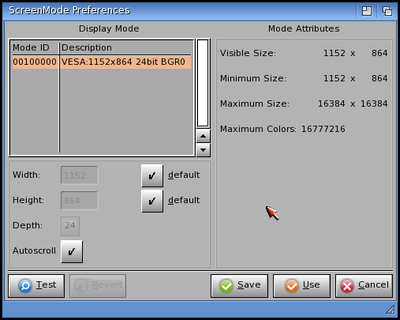
First, I attached the AmigaForever CD to VirtualBox. After starting Icaros, I selected My Software » AmigaApps » Setup-AmiBridge from the menu. This launches a set of scripts to install JanusUAE.
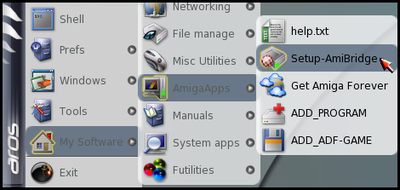
In the Setup-AmiBridge window, the AmigaForever CD is listed as a source, and I chose it.
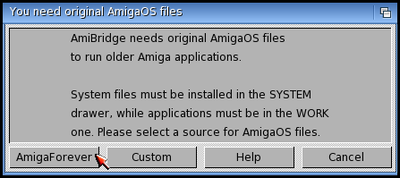
Clicking the AmigaForever button launches an IconX window which shows the files being copied. The files were copied so quickly, I only managed to get a screenshot of the last two copied. The scripts make a complicated task very simple.

After installation, a window shows two steps needed to enable coherency mode. This is the same as "seamless" mode in VirtualBox. You can make JanusUAE share the Wanderer desktop with Icaros.

After installation is complete, a new icon is added to the menu to launch JanusUAE.
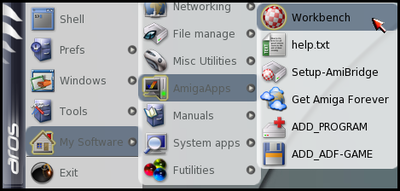
After launching, we see the pre-configured AmigaForever's UAE Workbench desktop in 800x600x4 resolution. (4 bits is only 16 colors, but the default resolution should be 16 bits, which is 256 colors.) No problem. Using the ScreenMode button at the bottom of the screen, we'll change this.
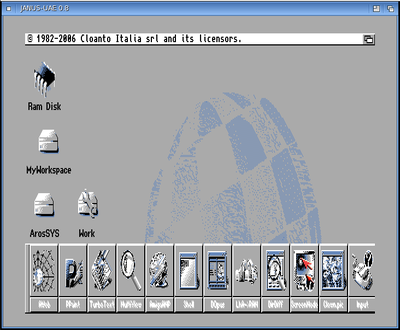
There are many graphics modes offered, including standard Amiga NTSC and PAL ones. We'll use the uaegfx driver with a resolution of 1024x768x32 for full color. After choosing, press the Save button.
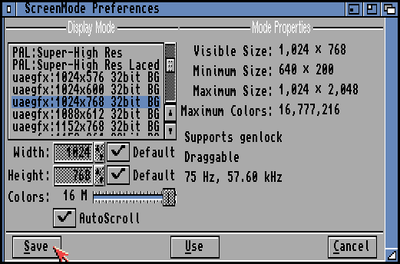
The screen has reset, but we lost the program launcher bar at the bottom of the screen. We're running an emulator inside an Icaros window, so we'll just close the window and start JanusUAE again.
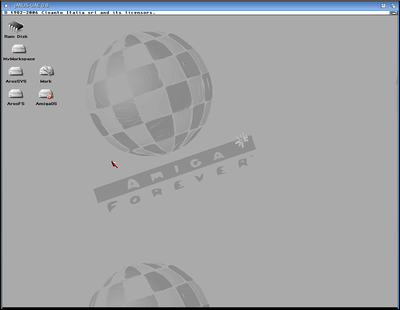
All the drive icons are lined up nicely on the desktop, and we have our program launcher bar back again.
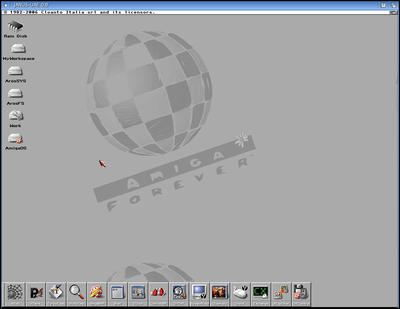
The Setup-AmiBridge scripts have set up UAE drives, (Ram Disk, Work and AmigaOS), as well as shared AROS drives. The bottom (active) window shows the contents of the AmigaOS:WBStartup drawer. Any commodities (memory resident programs) desired go here, and are loaded when Workbench starts.
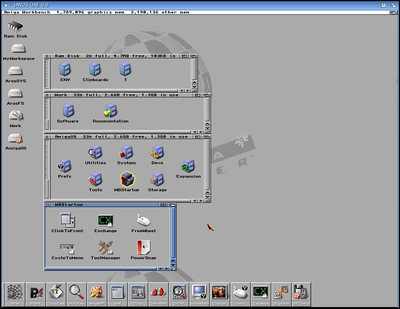
The first program button on the left is for AWeb, an older web browser. Pressing the button, we get the AmigaForever documentation by default. Trying to open Google's main page resulted in a meditation guru screen. You won't see that from AROS. This could be a result of running an emulator within an emulator, incorrect settings, or an incomplete setup between the Icaros host and the JanusUAE client. Whoops! Time to close JanusUAE and start again.
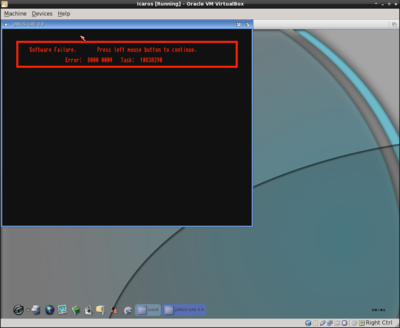
Running the DirectoryOpus program from the JanusUAE program launcher bar gives us a completely different desktop interface than Workbench.
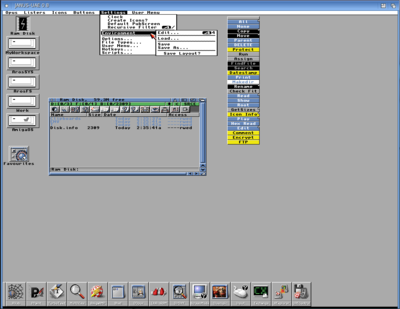
I tried a couple of programs from my Amiga magazine CDs, and they both worked. I didn't attempt anything that is graphics intensive. It's time to close JanusUAE, and the proper way to do it is by pressing the last button on the right of the program launcher bar, (UAEConfig). Click the Quit UAE button to exit.
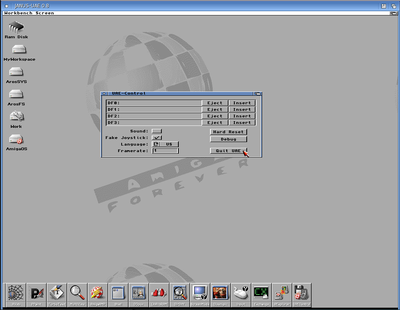
Before closing this last article on Icaros, I'd like to mention a new enhanced version of AROS, AROS Broadway, for three reasons. First of all, it has a different program launcher called Quickstarter. It expands both vertically and horizontally to give quick access to selected applications.
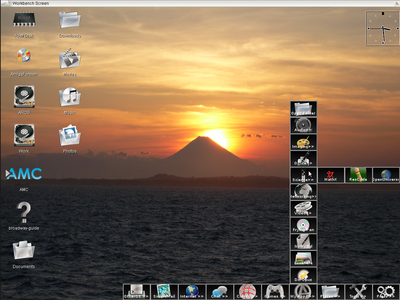
Second, it implements a multi-user system, using a setup tool called Login.
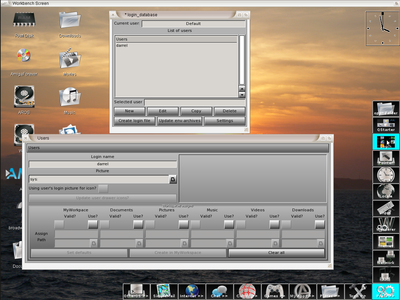
Last, but not least, not only are desktop icons implemented, the broadway-guide icon launches a short video tutorial.
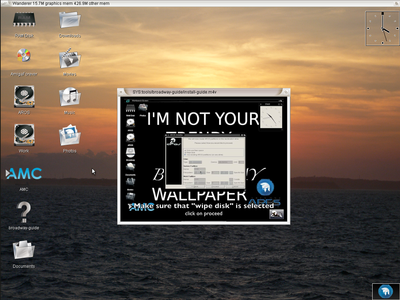
Icaros does, indeed, have the same capabilities. It's just that AROS Broadway has implemented them "out of the box".
